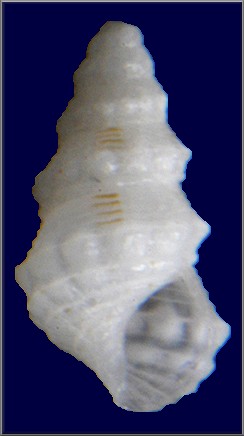| Ittibittium oryza (Mørch, 1876) |
 |
| Millar’s Beach, Eleuthera, Bahamas (1.7 mm.). Digital image by David Kirsh. |
| Comments By Harry G. Lee |
|
Despite the fact that it is one of the most common marine gastropods in the West Indies, this species was overlooked by Abbott and just about everyone else until the 21st century. Because much of the story of the unraveling of its systematics appeared in rare and obscure literature, I think some scrutiny is warranted. Here's a chronology: The Danish malacologist Otto Andreas Lowson Mørch (1876 <https://www.biodiversitylibrary.org/page/15854528>) described a 2.3 mm shell from St. Thomas (then a colony of Denmark) adequately but without figure and tentatively assigned it to Bittium. Gordon Nowell-Usticke (1969) described and figured (for the first time) the same taxon as Bittium varium var. turricula without reference to Mørch. 1970-1980 I found hundreds of specimens in NW Eleuthera and was frustrated by my inability to find a name for the species (or genus). We knew of the Usticke work, but I wasn't able to get my hands on it until years later. Houbrick (1974 <https://www.biodiversitylibrary.org/page/41114257>) mentioned the Mørch taxon, its type locality, his failure to locate type material, and suggested it was a Bittium Vokes and Vokes (1984: pl. 50, fig. 8) presented the only other pre-21st Century image of the species, labeling it "? Cerithium species" [quotes added]. I immediately recognized it as my Eleuthera puzzler. Marien Faber (1988) located possible primary type material of Bittium varium var. turricula Usticke, 1969 at the American Museum of Natural History (AMNH) and opined that it was an otherwise un-named taxon. <https://www.researchgate.net/publication/265736506_Faber_M_J_1988_The_malacological_taxa_of_Gordon_W_Nowell-Usticke> Houbrick (1993: <https://www.biodiversitylibrary.org/page/13149484>) recognized the lineage as meriting generic rank [Ittibittium] but was unaware of its occurrence outside the Indo-West Pacific. His choice of the generic epithet, although tongue-in-cheek, was quite apt. Faber (1995) further analyzed AMNH Usticke material referred to Bittium varium var. turricula and opined the best placement was Ittibittium Houbrick, 1993. Faber (2005) succeeded where Houbrick didn't; he personally visited the Zoologisk Museum, Kjøbenhavn (the oldest natural history museum in the world; presently incorporated into the Statens Naturhistoriske Museum) and located the Mørch type material. He proposed a lectotype for Cerithium oryza, recognized the synonymy of the Mørch and Usticke taxa, and proposed the new combination Ittibittium oryza (Mørch, 1876), the binomen by which we know this shell today. Abbott, R.T., 1974. American Seashells, 2nd ed. Van Nostrand Reinhold, New York. [viii] + 663 pp. + 24 pls. Faber, M.J., 1995. New data on mollusc species described by Gordon W. Nowell-Usticke. De Kreukel 31: 59-69. Faber, M.J., 2005. The Caribbean marine gastropods described by Otto Andreas Lawson [sic] Mørch. 1: some type specimens and identifications (Gastropoda: Prosobranchia). Miscellanea Malacologica 1(5): 81-99,. December 28. Vokes, H.E. and E.H. Vokes, "1983" [1984]. Distribution of shallow-water marine Mollusca, Yucatan Peninsula, Mexico. Mesoamerican Ecological Institute, Monograph 1, Middle American Research Institute, Publication 54: i-viii + 1-183, incl. 50. |